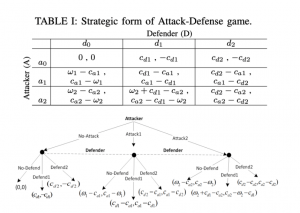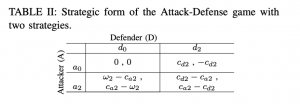A Game Theory Approach to Cyber Warfare
Cynthia Enofe
Networks 2040
09/28/2020
A Game Theory Approach to Cyber Warfare
Authors: Afraa Attiah , Mainak Chatterjee , Cliff C. Zou
Title: “A Game Theoretic Approach to Model Cyber Attack and Defense Strategies”
Link: http://www.cs.ucf.edu/~czou/research/wormSimulation/Cyber-Game-ICC18.pdf
With the evolution of technology within society and the now ever growing advancement of cybersecurity and cyber warfare in the recent decades, the techniques and measures taken for one to win, or rather, effectively ward off a cyber attack from an enemy is essential. Typically, however, when it comes to the topic of cyber warfare, many are focused on the defense aspect rather than understanding the game of cyber warfare from an attack perspective too in order to aid a defense plan. Understanding cyber warfare from an attackers perspective, specifically with the help of a game theory approach, allows for one to understand the mixed strategy Nash equilibriums that exist and arrive at a realistic understanding of cyber warfare where each side is utilizing a variety of best strategies, rather than objectively listing possible attacks and preparing for them. Essentially, leaving a blind spot open on the defenders side, or leaving them ill prepared for a best strategy attack from an enemy.
According to “A Game Theoretic Approach to Model Cyber Attack and Defense Strategies”, there is a need for a rather more realistic approach to cyber warfare where both sides are “intelligent and will dynamically change their attack or defense strategies in order to gain the upper hand.” The authors present a game theory approach to a non cooperative cyber game ultimately to conclude that this type of approach provides more fruitful data to cyber warfare. Each side’s strategy is determined by a variety of factors: “the strategy’s cost, potential attack gain/damage, and effectiveness in anticipating the opponent’s strategy.” Particularly, with this dynamic game, there are two players, the attacker and the defender, and each player has a variety of strategies to select from, zero level attacks/defenses (1) up to high level attacks/defenses (3), rather than the typical two strategies in many Nash equilibrium because “attackers and defenders experience different cost to benefit affects in order to achieve their success in either attack or defense.”
Table 1 shows the mixed strategy equilibriums of each attack/defense strategy taken in response to their opponents. Each choice results in its own probability based upon the aforementioned factors. Furthermore, this approach was compared to a two strategy Nash equilibrium. When the payoff matrix is determined it is seen that the probability of each player playing one or the other strategy is equal and therefore no player has incentive to change their strategy.

